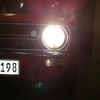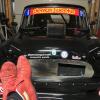Hi everyone,
(I think this has been asked and answered before, but I was getting a bit confused when looking for an answer. )
One of the wheel studs snapped on my car two nights back (dodgy wheel nuts). The other was so weak that when I tightened it up it snapped too. Now I have replacement studs (and nuts for a steel wheel that I am going to use in the interim), I was wondering what the correct procedure was to remove the existing studs and replace them. I figure it'd be best to replace all 4 studs as the other two would have been loaded incorrectly when the studs broke.
I've done the job on drums before, and the process was to remove the castle nut, the drum and then slide off the drive flange.
On the discs, it looks as if the disc and flange are one piece (or are attached with little securing screws), should I remove the castle nut, then the caliper and then the entire disc?
Thanks for the assistance,
Vinay


















